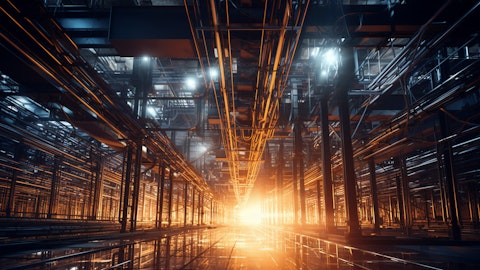Michael Dudas: Duke, it seemed like the life plug went off with your utility clients and everybody because of AI, as you discussed earlier, data center, demand that people want to just get out and spend and do stuff. How do you — how you guys allocate your very dear and tight resources relative to your client base or where the opportunities are? And is the demand for contracting and your type of services very tight right now relative to supply? And how is that relative to your current ability to bring folks on and under graduation rates at the colleges. And are the utilities maybe pushing off some of those retirements because they’re just going to be so busy?
Duke Austin: I think on the transition side of the business, we’re seeing a significant amount of ramp there in areas. It’s spotty. No, we’re not anywhere near capacity from my standpoint. I think we’ve got a lot of room. We’ve not seen anything that would back us off, to say that we’re concerned with labor at this point. We’re in good shape. Look, we have a good look at it, a good five-year look at what we see, very close to the business, very close to our clients. We work with them quite a bit on long-term natures and programs and what’s going on, when you go from West to East and the coverage that we have, you’re able to see the things that we know are going to happen, they start in the West like when you start to see vehicle penetration in the West, you know it’s going to move across the country.
And we’re starting to see those impacts. I think Edison had a good report on kind of how their grid is changing. And I think it gets — it gets worse, not better. I think capital goes up even from what they’re seeing. And I think you’ll continue to see that, as you see the total cost impacts of energy really require the grid to be robust to create the environment that you want, which is the customer builds going down, you have to build this infrastructure out to get the total cost of energy down. It’s happened in Europe, you’ll start to see more and more of that getting fed, which is really important for us to get in front of the necessary capital at the local level, at the state levels, so they understand in order to get the cost down and you’ve got to get the infrastructure.
And it’s also security for the country, is to get the grid where we need it to be. And you’re going to see that with loads going up in places, no one expected load to go up like this. The areas that you’re seeing a load, they did not expect data cities to come in and take, call it, 3 gigs, 5 gigs and they don’t want — they want secure power. So sometimes that requires multiple lines. And when you look at all this and you look at what’s coming at you, you’re backed up by this. The technology that’s coming into the world that requires our services, across the board, in the utilities rooting growth business, they’re growing. And it’s necessary for them to spend capital, it’s just a matter of getting it through from a federal push into the state regulators.
And we kind of said that all along that this is necessary, it’s going to come to a head, and you’re seeing it. This transition will be noisy. It will be things that you’ll see, it’s not straight up every day. It’s going to have CAGR look to it at times, in parts of the business. That’s why I like the portfolio so much, as we can move around and kind of get through this transition here and continue to what I believe perform at a high level and deliver the results we have.
Michael Dudas: Excellent. Good. Thank you.
Operator: Our next question comes from the line of Gus Richard with Northland Capital. Please proceed with your question.
Gus Richard: Yes, thanks for taking the question. The AI data center, not only needs a lot of power, but it needs a lot of bandwidth. And I’m just wondering if you guys are seeing along with the AI boom, a big demand for your comm services? And is there any synergies between those two pieces, the power and the comp? thank you.
Duke Austin: I think so. When you look at our communications business, I mean, we’ve done nicely, we’re growing double-digits. It’s not something that we’re investing a lot of capital in, but I do see it. I do see technology itself needing — you’re going to strip some of the fiber capacity, are stripping some of the fiber capacity out there. And especially when you start putting big data in different parts of the country, it’s much easier to build a telecom line and get telecom service, than it is transmission. So, sometimes in my mind, you’ll see data centers start to locate, where the power is, almost. And right now, if you can’t get power to the East and you can’t get it to the West, you start to see the Midwest build. And then if you can’t get it there, you start to see the South build.
So, everywhere that you can get affordable power today or in the next 24 months, you’ll start to see data centers go up. Even if there’s not fiber, so you’re going to get fiber going to them, at some point, nodes. Certainly, some of it is getting alleviated with satellites, things like that, but still you need the fiber on the ground. So, I do believe they’ll push it, and yes, there’s opportunity.
Gus Richard: Got it. And then just on the underground side. There’s — there was a pause in three years out on build-out of LNG export capacity. And I’m just wondering what you’re seeing in that business are projects still moving forward? And just the state of natural gas and that business for you?
Duke Austin: It’s $500 million to $600 million in the guidance, it will be $500 million to $600 million, next year, in the next year and the next year. We don’t — we’re not going to — that’s why we moved off long-haul pipe and big pipe. We just can’t — we can’t build the business around it. It’s certainly something, we’ll take every bit of opportunity we can. We did $1 billion plus in big pipe last year. So, you’re seeing some offset in the top line because of that because we guided $500 million to $600 million. Is there opportunities for $1 billion plus? Sure. But the government regulations and difficulty in building a large diameter pipe, anywhere in the country, but Canada is — a little better opportunities in Canada.
But we’re just — we can’t take that and build it in guidance and give you any kind of firmness to our numbers. So, I — look, I think there’s opportunities. But it doesn’t — LNG, if everything goes and it doesn’t go, it doesn’t matter to the guide we’ve given you. It doesn’t matter.
Gus Richard: Got it. Thanks so much.
Operator: Our next question comes from the line of Brian Brophy with Stifel. Please proceed with your question.
Brian Brophy: Yes, thanks. Good morning everybody. I wanted to ask about free cash flow guidance. was quite a bit higher than we were expecting? Your free cash flow conversion is above long-term targets this year. How much of this is more of the onetime collections that you called out, in the commentary versus potentially a more permanent improvement in free cash flow conversion, here as renewable energy mix has grown? Thanks.
Jayshree Desai: Yes. As we’ve talked about in the Investor Day, and as you’ve seen in the fourth quarter last year, the renewable business with the way those contracts are set up, has a very favorable cash flow profile and the working capital profile is very good. And so, as revenue and renewable side pushes up, you’ll see better conversion just as we saw in 2023. Going into 2024, we did take that into consideration, but we did range it. There’s a range for a reason. As I just said, renewables can push us in the higher end of that range of 45% to 55% that we talked about at Investor Day. But if you’ve got — if it’s more growth coming from our electric and underground segments, it can push the other way, right? And so we’ve given you what we think is a good prudent look at where free cash flow will be.
But having said that, if the mix of work between renewables and electric and utility underground changes, you will see outside of that range or either a high end of that range or the low end of the range. The one-time cash flow impact of the large Canadian Renewable project, we do believe we will collect next year. We — excuse me, in 2024. We — as we talked about the last several quarters, as construction winds down, which we expect in the next several months, a couple of months. Conversations with the customer continues to go very well. So, we’re optimistic we’ll be able to collect all of that as well this year. But on an ongoing basis, I think you would be good to look at a range of between 45% to 55% conversion.
Brian Brophy: Okay. Thanks. And then just wanted to touch on how you’re thinking about capital allocation more broadly this year given that you’re in line with some of your longer term leverage targets now? Should we be expecting more buybacks this year? How are you thinking about M&A? Any thoughts there would be helpful. Thanks.
Duke Austin: Sure. We’ll be opportunistic in how we look at it like we have in the past, no different. We are below some of our targets. It allows us flexibility, which I like a lot. Certainly, there’s things that we can be opportunistic in. But the strategies won’t change. We’ve laid out a good strategy plan. Can we get — can we go faster, as we delever, things like that, sure. So, I think ultimately, we’re moving faster across the five-year plan. As we said last quarter and continue to say, we’re moving faster through it. We’ll be opportunistic with the balance sheet. But again, with the conservative nature of the company and — we’ll — we have opportunities, across multiple fronts, and we’ll take advantage of all of them.
Brian Brophy: Excellent. Thanks. I’ll pass it on.
Operator: Our next question comes from the line of Martin Malloy with Johnson Rice. Please proceed with your question.
Martin Malloy: Good morning. I wanted to ask about the trend with higher attach rates for energy storage associated with utility scale solar and wind projects and could you maybe speak to how that impacts your scope of work and margins?
Duke Austin: The tax rate, the PTC and ITCs and those things, they’re in place. I’ve not seen them come off at this point, whether it’s IRA or PTC, how it moves in or ITCs, how it moves in, I think it’s the same. Now, if it was repealed, I do — you could see some issues there. I do not believe that will be the case going forward. That’s something that gives certainty to the industry. So, I continue to believe that how you get them and our customers have been able to get in front of this. And I think our customer base is — these things kind of figured out. The IRA has some different things, you can get more, not less. So, I actually think we’re in early stages of the IRA, which should give it’s going forward, not less. So, I see it as more opportunities.
We should check the box on from a standpoint of U.S.-type apprenticeship programs, U.S. type materials, things of that nature, even internally. So, we really set ourselves up to take advantage of that for the customer. So, I feel good about it. I’m not seeing it slow down from that standpoint. I mean, everyone’s watching from our customer viewpoint, they got it figured out and tax credit figured out.
Martin Malloy: I’m sorry, I appreciate your comments. I wasn’t clear, I was actually asking about energy storage, tax rate, at utility scale solar and wind projects with adding energy storage in conjunction with those projects and what that means for your scope of work and profit margin soon?
Duke Austin: I think — I mean, I think I understand what you’re saying. But from a tax rate standpoint, I don’t know if it does much, but from a combination, it actually expands many of the projects that we’ve built in the past are adding storage to it. Our, storage business is growing nicely, and our battery business is growing nicely. So, I like that. We continue to add that capability and get more refine there, as we move forward across geographies. So, when you ask that, I think it’s just more opportunity to increase the size and scope of these projects.
Martin Malloy: Great. Thank you.
Operator: Our next question comes from the line of Adam Thalhimer with Thompson Davis & Company. Please proceed with your question.
Adam Thalhimer: Hey good morning guys. Congrats on the solid result. Quick question on the project funnel for Blattner, is that still dominated by solar? Or are you seeing wind pick up?
Duke Austin: I mean, SunZia is a nice project that’s on the wind side. We’re seeing more opportunities repower. I think you’ll see a lot of repower work going forward. You’re in early stages of the cycle coming back from wind. So, we’re starting to see more and more in the outer years of wind coming into the portfolio. I don’t think it’s going to be any like large windfall in 2024 by any means, but I do think 2025, 2026, it starts to move up significantly as we move out in the outer years, the curves get, where wind makes a lot more sense in areas. So, you’ll start — transmission needs to be built, too. Like we’ve got to get the transmission built before you can get wind out. And that’s the other piece of this is you need long-haul transmission to move wind out of those sources into load centers. So, it’s very taking out the egg sometimes, and I do think both are coming into play. And the Wind business gets better from, call it, 2024 on.
Adam Thalhimer: That’s great. And then I also wanted to get your early thoughts on PTT and the timing of the capacity expansion there?
Duke Austin: We continue to expand capacity there. There’s a lot of things that we can do internally to expand. We’re expanding like the business ever more so today than we did — today looked at it. So, it gets better the opportunities and synergies, the things that we can do for the clients with PTT, U.S. base, Union in Pennsylvania, a great place to invest and we’re lacking that business a lot.
Adam Thalhimer: Thanks Duke.
Operator: Our next question comes from the line of Sangita Jain with KeyBanc Capital Markets. Please proceed with your question.
Sangita Jain: Thank you so much for taking my question. So, you gave earnings cadence of — which is kind of back-end loaded, which is generally normal for you. And I was wondering if it was just weather and seasonality or if there is something more to read into how the projects ramp as the year progresses?
Jayshree Desai: No, I think it’s mostly seasonality typical of what we run. We did — as Duke talked about, there’s a little bit of Canadian pressure in the first half of the year. But it’s just normal seasonality. And we do expect with the additional SunZia work and some other projects, more back half weighted, but again, nothing more unusual than that.
Sangita Jain: Great. Thank you. And I just have one follow-up. And that’s on the renewables side. The Biden moratorium on the tariffs comes to an end in June. So, I was wondering if you’re seeing any kind of pull-forward on the part of developers, who want to install within that 180-day timeline between purchase and installation?
Jayshree Desai: The customers we work with, have been planning for the tariff situation for a while now. So, I think we’re — our customers have been planning this moratorium being lifted in June. So, it’s — I don’t know — I can’t answer directly, if we’re seeing some pull forward, I just know that the customers we’ve been working with for years, now planned for this very well. They know how to work this. They’ve been prudent about how they think about their panel procurement, and we continue to see good growth in our renewable segment as a result.


